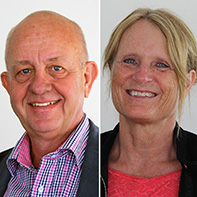Inaugural lectures by Tinne Hoff Kjeldsen & Steffen Lauritzen
Friday 20 November 2015 two professors will give you an insight in the diversity of mathematical sciences when they each give their inaugural lectures.
 Professor in Statistics Steffen Lauritzen talks about graphical models while Tinne Hoff Kjeldsen, professor in History of Modern Mathematics, talks about the development of convexity, operations research and mathematical biology in 20th century mathematics.
Professor in Statistics Steffen Lauritzen talks about graphical models while Tinne Hoff Kjeldsen, professor in History of Modern Mathematics, talks about the development of convexity, operations research and mathematical biology in 20th century mathematics.
The lectures take place in Auditorium 3, Universitetsparken 5 (H.C. Ørsted Instituttet). From 13:15 to 13:55 Steffen Lauritzen talks, from 14:15 to 14:55 Tinne Hoff Kjeldsen.
At 15:00 the Department of Mathematical Sciences will host a public reception in the lunch room at 4th floor in the E-building.
Steffen Lauritzen’s lecture is titled “Challenges in Graphical Models”:
“Graphical models have been around for almost forty years and have in that period played an essential part in my scientific life. In the lecture I shall through examples attempt to explain what they are, how they can be used, and why they are interesting. I shall identify important milestones in their past and give an impression of some of the recent developments and modern challenges associated with their theory and application - challenges that I hope to address in the near future. “
Tinne Hoff Kjeldsen’s lecture is titled “The art of invention, World War II, and the “power of a superman” in the development of convexity, operations research and mathematical biology in 20th century mathematics”:
“The 20th century has been called “the golden age of mathematics”. It was a century with a trend towards a growing abstraction and autonomy of mathematics on the one hand and the emergence of many new disciplines in applied mathematics on the other hand.
"In the talk we will visit three such episodes of 20th century mathematics by focusing on different driving forces that led the mathematicians to try out new concepts and to engage in new mathematical developments: The “inventive art” of Hermann Minkowski that led him to introduce the concept of a general convex body, the significance of World War II for the development of operations research, and Nicolas Rashevsky’s wish for the power of a superman for developing a physicomathematical foundations of biology.”
